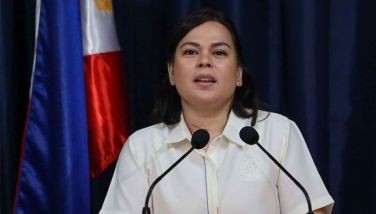Metro Manila in the pink of health

March 26, 2004 | 12:00am
My daughter Rachel asked me last Sunday how come some street signs and even the urinals designed for men are painted pink. She probably thought I knew all the answers, specially because the choice of pink must have been made by my friend, MMDA Chairman Bayani Fernando. I said, I never thought much about that but would ask Bayani when I see him next Tuesday.
And I did ask Bayani. Well, you won’t find the color pink in any international traffic signage manual, that much Bayani admits. Pink is pure Bayani. No, it is not the favorite color of his wife, Marikina Mayor Marides. And no, he is not gay. He said he chose pink because he has this vision of Metro Manila being in the pink of health. I was a bit dumbfounded by this explanation but he had more.
You see, he said, in most cities abroad, there is more motor traffic than pedestrian traffic and road signs are designed for the motorists. But in Metro Manila, there are more pedestrians. He wants pedestrians to have traffic signs directed at them, color coded attractively so that when they see pink, they know it is meant for them, the folks who are on foot.
Why pink? He asked, why not pink? He finds pink attractive, happy. In fact, he said he painted the walls of one flyover a combination of pink and baby blue. I haven’t seen that flyover and I forget exactly where he said it is. But that must look like some nursery in the sky. I haven’t been to Bayani’s house. I wonder if it is painted pink!
I told Bayani about how the Singaporeans and the Malaysians allowed ivy to grow on the walls of overpasses and I thought that was a great idea. It covers the cold gray concrete and graffiti can’t be scrawled on the plants. Bayani does not think the ivy idea that great because ivy’s colored green. He does not seem to like the color green. He finds green drab. I don’t agree with him but I am not the one calling the shots for Metro Manila roadways. He said he would plant more colorful clinging plants. That’s his operative word: color.
You can’t always agree with Bayani, and his taste for colors in public places may not be conventional. But at least, he is creative. Notice how they tried to convert graffiti into interesting art? If you can’t lick ‘em’ join ‘em’ only be more creative and artistic with colorful Mondrian-inspired designs painted over urban graffiti.
My neighbors in White Plains should be reassured that Bayani will light up that wide White Plains avenue soon and put dividers down the center. But if you guys want to widen Katipunan Avenue in front of White Plains, you have to follow up the promise made to me by J. Antonio Leviste, otherwise known as Loren’s husband, that he would make that happen. Tony gave me that promise some months ago, before Loren became the running mate of FPJ. I am not sure how to collect on that promise while the iron is hot.
I received this e-mail reacting to the column last Monday on medical education from an expat Pinoy doctor, Michael S. Nolledo, MD, Clinical Assistant Professor UMDNJ-Robert Wood Johnson Medical School New Brunswick, New Jersey.
I agree wholeheartedly with many of the points you raised regarding Medical Education in the Philippines. It is true that we turn out too many inadequately trained physicians. The fact that many of our physicians strive to be nurses in the US and elsewhere further emphasizes this point. In addition, I would like to make the following observations:
There should exist a system where the physicians involved in training medical students and residents can do so either full time or close to full time without having to worry about money. This would solve two problems – one can make medical education their top priority and at the same time, not have to worry about training their future competition since they are not in a private practice setting. This is the case here in the US where full time academicians schedule their clinical and patient responsibilities around their teaching responsibilities and not the other way around.
You made the point that practicing medicine in the United States is no different than practicing in the Philippines. If that is the case, then the academic credentials and board certifications achieved in the US and other similar countries should be honored in the Philippines. In my case for instance, I am board certified in four specialties in the US and if I were to return to Manila, none of these certifications would be recognized there – I have been told I would have to essentially start from scratch and take the exams there.
As you might imagine, this is a huge disincentive to returning home. I can tell you many stories of friends of mine who actually returned to Manila only to return to the US because the medical community did not fully welcome them back. It would go a long way if foreign-trained physicians are welcomed back – meaning the board certifications they have achieved overseas are recognized by the equivalent local boards and encouraged to participate in both the academic and clinical (i.e. private practice) environment.
I agree there should be access not just to the latest medical technologies but to the latest medical information. The standard of care should be what we term evidence-based medicine. The right thing to do with a certain patient for a certain disease should NOT be solely based on what one’s personal experience is but should be based on what the medical literature supports. While one should take into account personal experience, this should be considered in the context of the published experience of other physicians.
We should teach medical students and trainees HOW to think and HOW to approach problems. While it is important to know how to gather information – through eliciting a history and examining the patient, it is equally important to know how to process this information and what to do with it once we have processed it.
In this light, we should teach our students and trainees to always question what their teachers tell them. As teachers, we should welcome these questions and be able to answer them using scientific arguments and not shoot someone down with the attitude that "It is so because I say it is so." If as a teacher you find it difficult to answer the questions of your students then perhaps it is time you did some reading yourself.
These are but some observations I have made and I don’t pretend to have the answers, In fact I often have difficulty thinking of solutions. But things should start with thinking. We should want to change things before any changes can be made.
Speaking of doctors, a local doctor sent this one in.
A drunk, who reeked of beer sat down, on a subway seat next to a priest. The man’s tie was stained, his face was plastered with red lipstick and a half empty bottle of gin was sticking out of his torn coat pocket. He opened his newspaper and began reading.
After a few minutes the man turned to the priest and asked, "Tell me, Father, what causes arthritis?"
The priest replied, "My son, it is caused by loose living, being with cheap, wicked women, too much alcohol and a contempt for your fellow man, sleeping around with prostitutes and a lack of personal hygiene."
The drunk muttered in response, "Well, I’ll be darned," and returned to his paper.
The priest, thinking about what he had said, put his hand gently on the man’s arm and apologized. "I’m sorry. I should not have come on so strong. How long have you had arthritis?"
"I don’t have arthritis, Father," the drunk replied. "I was just reading here that the Pope does.
Boo Chanco’s e-mail address is [email protected]
And I did ask Bayani. Well, you won’t find the color pink in any international traffic signage manual, that much Bayani admits. Pink is pure Bayani. No, it is not the favorite color of his wife, Marikina Mayor Marides. And no, he is not gay. He said he chose pink because he has this vision of Metro Manila being in the pink of health. I was a bit dumbfounded by this explanation but he had more.
You see, he said, in most cities abroad, there is more motor traffic than pedestrian traffic and road signs are designed for the motorists. But in Metro Manila, there are more pedestrians. He wants pedestrians to have traffic signs directed at them, color coded attractively so that when they see pink, they know it is meant for them, the folks who are on foot.
Why pink? He asked, why not pink? He finds pink attractive, happy. In fact, he said he painted the walls of one flyover a combination of pink and baby blue. I haven’t seen that flyover and I forget exactly where he said it is. But that must look like some nursery in the sky. I haven’t been to Bayani’s house. I wonder if it is painted pink!
I told Bayani about how the Singaporeans and the Malaysians allowed ivy to grow on the walls of overpasses and I thought that was a great idea. It covers the cold gray concrete and graffiti can’t be scrawled on the plants. Bayani does not think the ivy idea that great because ivy’s colored green. He does not seem to like the color green. He finds green drab. I don’t agree with him but I am not the one calling the shots for Metro Manila roadways. He said he would plant more colorful clinging plants. That’s his operative word: color.
You can’t always agree with Bayani, and his taste for colors in public places may not be conventional. But at least, he is creative. Notice how they tried to convert graffiti into interesting art? If you can’t lick ‘em’ join ‘em’ only be more creative and artistic with colorful Mondrian-inspired designs painted over urban graffiti.
My neighbors in White Plains should be reassured that Bayani will light up that wide White Plains avenue soon and put dividers down the center. But if you guys want to widen Katipunan Avenue in front of White Plains, you have to follow up the promise made to me by J. Antonio Leviste, otherwise known as Loren’s husband, that he would make that happen. Tony gave me that promise some months ago, before Loren became the running mate of FPJ. I am not sure how to collect on that promise while the iron is hot.
I agree wholeheartedly with many of the points you raised regarding Medical Education in the Philippines. It is true that we turn out too many inadequately trained physicians. The fact that many of our physicians strive to be nurses in the US and elsewhere further emphasizes this point. In addition, I would like to make the following observations:
There should exist a system where the physicians involved in training medical students and residents can do so either full time or close to full time without having to worry about money. This would solve two problems – one can make medical education their top priority and at the same time, not have to worry about training their future competition since they are not in a private practice setting. This is the case here in the US where full time academicians schedule their clinical and patient responsibilities around their teaching responsibilities and not the other way around.
You made the point that practicing medicine in the United States is no different than practicing in the Philippines. If that is the case, then the academic credentials and board certifications achieved in the US and other similar countries should be honored in the Philippines. In my case for instance, I am board certified in four specialties in the US and if I were to return to Manila, none of these certifications would be recognized there – I have been told I would have to essentially start from scratch and take the exams there.
As you might imagine, this is a huge disincentive to returning home. I can tell you many stories of friends of mine who actually returned to Manila only to return to the US because the medical community did not fully welcome them back. It would go a long way if foreign-trained physicians are welcomed back – meaning the board certifications they have achieved overseas are recognized by the equivalent local boards and encouraged to participate in both the academic and clinical (i.e. private practice) environment.
I agree there should be access not just to the latest medical technologies but to the latest medical information. The standard of care should be what we term evidence-based medicine. The right thing to do with a certain patient for a certain disease should NOT be solely based on what one’s personal experience is but should be based on what the medical literature supports. While one should take into account personal experience, this should be considered in the context of the published experience of other physicians.
We should teach medical students and trainees HOW to think and HOW to approach problems. While it is important to know how to gather information – through eliciting a history and examining the patient, it is equally important to know how to process this information and what to do with it once we have processed it.
In this light, we should teach our students and trainees to always question what their teachers tell them. As teachers, we should welcome these questions and be able to answer them using scientific arguments and not shoot someone down with the attitude that "It is so because I say it is so." If as a teacher you find it difficult to answer the questions of your students then perhaps it is time you did some reading yourself.
These are but some observations I have made and I don’t pretend to have the answers, In fact I often have difficulty thinking of solutions. But things should start with thinking. We should want to change things before any changes can be made.
A drunk, who reeked of beer sat down, on a subway seat next to a priest. The man’s tie was stained, his face was plastered with red lipstick and a half empty bottle of gin was sticking out of his torn coat pocket. He opened his newspaper and began reading.
After a few minutes the man turned to the priest and asked, "Tell me, Father, what causes arthritis?"
The priest replied, "My son, it is caused by loose living, being with cheap, wicked women, too much alcohol and a contempt for your fellow man, sleeping around with prostitutes and a lack of personal hygiene."
The drunk muttered in response, "Well, I’ll be darned," and returned to his paper.
The priest, thinking about what he had said, put his hand gently on the man’s arm and apologized. "I’m sorry. I should not have come on so strong. How long have you had arthritis?"
"I don’t have arthritis, Father," the drunk replied. "I was just reading here that the Pope does.
Boo Chanco’s e-mail address is [email protected]
BrandSpace Articles
<
>
- Latest
- Trending
Trending
Latest
Trending
Latest
Recommended





























